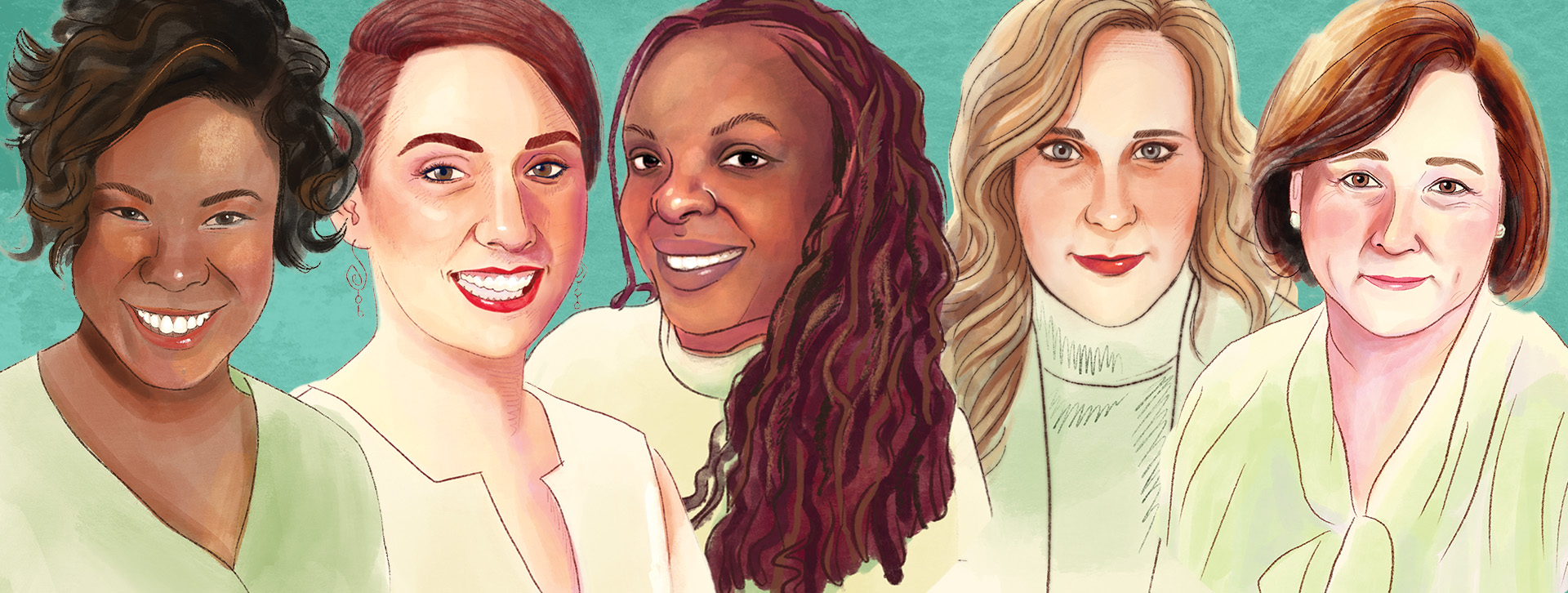Hollins Women in Philanthropy
It’s been an amazing year and change for female-driven philanthropy. Mega-donor MacKenzie Scott gave $2.1 billion in 2023 and continues to donate $1 to $2 million gifts to hundreds of U.S. nonprofits this year. In May, Melinda Gates founded Pivotal, pledging to give $1 billion by year’s end to U.S. nonprofits working to protect the rights of and empower women and girls.
Women are leading the surge of giving circles in the country. Over the last seven years, the number of collective giving groups more than doubled, with women comprising 84% of all members. Almost half of the 4,000 circles are female-only (source: Philanthropy Together).
These trends beg the question: Are women more generous than men? While men’s net worth is roughly double that of women, as women’s income increases, they’re more likely to give than men, according to the Indiana University Women’s Philanthropy Institute.
We went to the source—five Hollins graduates and philanthropy leaders—for their take on the trends, the industry, their career journey, and the impact women can have on the conversation when money talks.
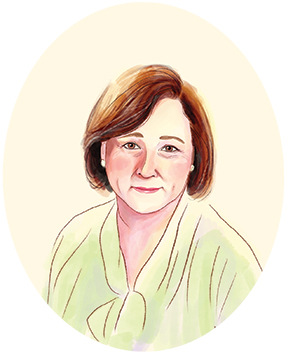 Wendy McGrady ’88
Wendy McGrady ’88
Executive Vice President, The Curtis Group Incoming Chair, Giving USA Foundation
Women are making an impact through philanthropy and volunteering. They’re leveraging relationships and influence, using their vote, organizing, bringing friends to the process, leading, [creating] giving circles, staffing, or leading a nonprofit and boards, and—more than ever—making policy decisions. I think women are giving more strategically than they have in the past, certainly with a gender equity lens but also toward leveraging their resources for partnerships, venture philanthropy, or raising up marginalized communities.
We’re half the population, but less than two percent of all dollars given in the U.S. are going to women’s and girls’ causes. If a woman is in a leadership position and not using [her] money, skills, experience, time, and connections to make a difference in [her] community or the world, then who’s going to do it? In an election year, if you care about women’s health, reproductive rights, or women’s leadership opportunities, you have a voice in your vote. Get in the game in some way.
Nobody sets out to be a fundraiser, and specifically a fundraising consultant. During Hollins, I had a summer job doing events. I learned that people burn out quickly in events and that the major gift side is what can make an organization fly. While working in marketing jobs, I got a call that Tidewater Community College needed a chief development officer. I did that for five years before joining the consultant firm I had worked with at Tidewater. I like playing a small role in advancing a lot of organizations. It feels good to help raise that tide that lifts all ships.
“Connectedness is what a lot of women can bring to the game.”
In fundraising and philanthropy, leadership makes or breaks it. When you’re in a nonprofit, you’re head down. Developing your board and bench for future leadership is not top of mind, but it can change the trajectory of your organization. Nonprofits probably don’t spend much thought or time on this until they’re ready to do a big campaign, build a building, or start an endowment. Then they think, “Oh, I don’t have anybody who can make those calls.”
Find your lane and run. You don’t have to be a major gift asker or the $100,000 check writer. You can be the organizer and host an event for people who can write the bigger checks. Connectedness is what a lot of women can bring to the game.
Some people are intimidated by the concept of [being a] philanthropist. If you look at it more in terms of a generosity of spirit, of lifting up the people around you, I think Hollins fostered that. I also was taught that we have the responsibility to do what we can to make the world a better place.
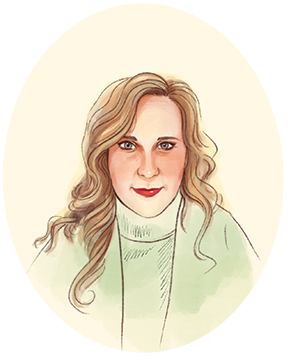 Anna Beth Gorman White ’04
Anna Beth Gorman White ’04
Chief Operating Officer, Women’s Foundation of Arkansas
I don’t necessarily think of myself as a philanthropist. I think of myself as an advocate for women and girls. [Growing up] and at Hollins, I would’ve said that I’m going to be a lawyer or maybe a lobbyist. My trajectory, which got me to Hollins, was that I always found safe spaces in women-serving organizations. I was a Girl Scout Gold Award recipient [the highest honor] and was raised in a family of Eagle Scouts, so scouting was a big deal. I earned a scholarship from my local Girl Scout Council, and Hollins gave me a Batten Scholarship. Hollins provided this incredibly safe, loving environment where, as small as it is, you meet girls that are so different from you. The real world isn’t homogeneous.
After Hollins, I worked for a law firm and then for the Texas Senate, but I was bored. I loved being a Girl Scout and thinking about solving problems to make the world a better place. [A friend] suggested I work for the Girl Scouts. Within a week, I had an interview at the local Girl Scout Council in Austin. The nonprofit sector is where I feel I find value and meaning. I’m passionate about helping women be the best version of themselves. I was an executive with the Girl Scouts of Arkansas for almost eight years. After my master’s in public administration and graduate certificate in nonprofit management, I was hired by the Women’s Foundation of Arkansas as its only employee. Now we have six full-time employees and a $2 million budget.
Women’s foundations address the systemic barriers and challenges that women and girls face. Each has a different lens based on where they are. I’m in a Southern, deep-red state, so the work that I do looks different from my peers in Colorado, Arizona, California, and New York right now. But this incredible network is addressing the problems that women face today.
I’m passionate about helping women be the best version of themselves.
I think nonprofits should operate like businesses. People want to invest in successful businesses. My profit looks like advocacy work to show how investing in women is the best possible investment because there is a multiplier effect. When you invest in a woman-serving organization or business, you’re investing in solving problems. You’re investing in transforming lives. A woman is going to turn her profit back into her community.
There is a huge transfer of wealth now, but institutions are getting it wrong. It’s being transferred from partner to partner first, not from one generation to the next. Women outlive men, and certain generations right now are coming into disposable income at different rates than we’ve ever seen before. That’s great for philanthropy but dangerous for women because they become objects of deceptive practices and people taking advantage of them. We’re trying to educate the financial institutions about how they should be talking to women because their products and services were designed by men for men. Women need a lawyer, a CPA, financial advisor, and a banker, and we need to make sure that they have similar values [as ours]. If not, they’re not going to lead you in the right direction.
Women, I think, are much more comfortable with the word “generous” than “philanthropic.” I want to encourage women that philanthropy is not something that is inaccessible to you. It’s about giving, but it’s also about finding the vehicles that align to your values. Write down your top five values and what’s been impactful in your life. Look for [ways] to be generous to those things.
There has been a movement in trust-based philanthropy in the last five years. When I give to Hollins, I trust that it is the expert on higher ed and how to serve women on college campuses. I am not that expert. I trust that the Girl Scouts are ensuring that the money I give today serves girls now and in ten years. Do your due diligence and research, [but] trust the nonprofit to use your gift well.
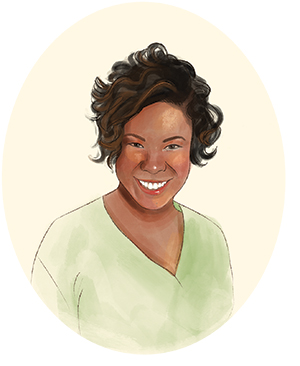 Shamecca Bryant ’04
Shamecca Bryant ’04
Founder and President, Bryant Consulting Solutions
I fell into this career because of the Hollins phonathon. I realized that I was very comfortable asking alumnae/i to support the current students. I also participated in various [campus] groups that led me to my passion for event planning, like the Black Student Union. My [early] jobs were doing events for the Peninsula Fine Arts Center in Newport News, Virginia, and the Make-a-Wish Foundation in Richmond. After my master’s degree in sociology with a policy focus at American University, I moved to the Triangle region to be development director, then executive director, for the Orange County Rape Crisis Center. This combination of advocacy, education, and prevention really hits all of the marks for how we create change in society.
I was one of a handful of Black executive directors in Chapel Hill. There were so few female leaders of color in the community. I was able to create my own network and opened my consulting business in 2015. I select projects that align with my personal values, usually social justice-related causes. Women of color have led in philanthropy for a very long time, and that work has gone unnoticed. I grew up in the Bronx and remember Black women collectively putting their resources together to help feed people, pool resources to house women [experiencing] domestic violence, and make sure kids went to school with all the resources they needed. We’ve defined philanthropy as making a large financial gift, but philanthropy in various communities can also be time.
Be strategic about how, about where you put your energies, how you pass the torch, and how you uplift the next generation who is going to be at the helm.
Women of color have far exceeded many regarding education and advanced degrees. They are now higher earners but are rarely asked to lead in the nonprofit sector. The church is the best example in terms of actual dollars and Black women leading various ministries. There is a shift that I’m seeing of Black women leading other nonprofits—and would love to continue to see because that impacts philanthropy for those causes.
It’s important for women to know when to get out of the way and to allow for other voices. I don’t need to serve on a board, but I can write a check. I know the things that I’m most passionate about and focus my energy there. Be strategic about how, about where you put your energies, how you pass the torch, and how you uplift the next generation who is going to be at the helm.
Use the Hollins network. When I first arrived in Chapel Hill, Wyndham Robertson ’58 personally took me around to vouch for me and my leadership. If Wyndham says that you’re a leader, people pay attention. I was 27 when I became an executive director. Wyndham didn’t step in and ask to be on the board. She said, “I know this young woman, and everyone needs to give her a chance.” Wyndham is a very good example of providing spaces for the next generation to be able to have a successful path. I brainstorm with Hollins women every day through a group chat. Every success and setback that I have ever had, a Hollins woman was there.
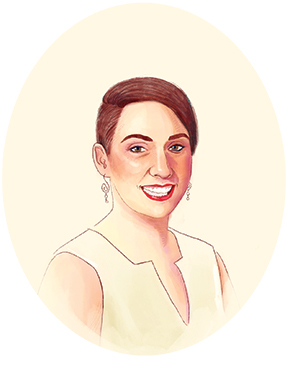 Kelsey DeForest ’13
Kelsey DeForest ’13
Northeast Philanthropy Officer, Nurse-Family Partnership
I went to college knowing I wanted to be a professional fundraiser. I graduated a semester early from high school and worked for the Cleveland Rape Crisis Center. They were doing a capital campaign, which was a fantastic moment to learn about fundraising. I learned quickly that most people are terrified of fundraising, but I am not. At Hollins, I was able to do internships on fundraising for statewide organizations, political campaigns, higher education, and political action committees. Hollins was transformational for me as a leader, and I was student government president. One thing that often gets overlooked are the skits and songs of Tinker Day and Ring Night, all the moments that help you be comfortable being silly, which make you a much more approachable leader. This has helped me create collaborative teams and is such a powerful tool that I draw on each day. [These skills] really help my current position raising funds and creating partnerships for two home visiting programs that serve families experiencing adverse social determinants of health, intergenerational cycles of poverty, trauma, intimate partner violence, substance use, and houselessness.
You get into fundraising because you believe in the impact that you have, but people burn out so quickly. People are undercompensated and not getting support from management to be successful in their work. You need to take time off, really disconnect, and set clear boundaries. I don’t respond to a donor email beyond work hours except in extreme cases to finalize a major gift. The Association of Fundraising Professionals and certifications are moving us toward being perceived as a genuine career sector like accounting and social work. It really magnifies my ability to work with my donors when they understand that I’m an expert in philanthropy and a thought partner on how they can have the biggest impact.
It really comes down to giving your values.
Women are the dominant force in fundraising teams and the origins of fundraising as a profession. [Historically] women had time to fill because their husbands were wealthy, their homes were staffed, and their children were with nannies or in boarding school. They fundraised for social causes. I think that is why historically, [the profession] is under-resourced and underpaid, that it’s a job for people that don’t need money. I’m very lucky to work in New York City, where the philanthropic sector has competitive salaries.
We’re in an exciting moment of women’s philanthropy. MacKenzie Scott is redefining a lot of what philanthropy looks like. As someone who works for an organization that’s been a beneficiary of one of her grants, I am already seeing the impact of the flexibility that she provides. It’s hard to [paint] any broad strokes about women as philanthropists because they are shaped so much from where in the country they are, economic and religious background. But I do see women philanthropists more willing to put the trust in the organizations to be the experts in how those dollars can be best used.
I’m really intentional about my own giving. I was very lucky to attend Hollins on a full scholarship, and it was very important to me to pay that forward by giving back. I pivoted a lot of my philanthropy in response to the COVID-19 pandemic and really looked at the resources that I could take for granted. One of the big causes I support now is my community library and anti-gentrification organization in my neighborhood in Flatbush, Brooklyn, recognizing that I am white living in a primarily Black and immigrant community. It really comes down to giving your values. Do your research, talk to people about where they give, and become a monthly donor—so many organizations rely on monthly donations. It lets you give larger amounts of money than if you’re just giving a one-off gift at the end of the year and really systematizes your philanthropy.
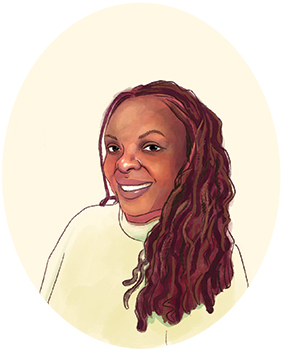 Anna Koranteng ’05
Anna Koranteng ’05
Manager of State and Foundation Services, National Committee for Quality Assurance
After graduation, I worked with marginalized families doing in-home therapy for families in Richmond. It was hard, impactful work, but I knew that I didn’t want to do that for the rest of my life. I went to North Carolina Central University for a master’s degree in sociology and discovered my love of research and gerontology. I ended up getting a second master’s in Gerontology from the University of North Carolina at Greensboro. I worked in institutional research and effectiveness at Bennett College, a historically Black women’s college, which set me up for my research trajectory. I recently worked as senior research analyst at digitalunited, a nonprofit focused on economic growth for Latina and Black women entrepreneurs and innovators. I just started a new position at NCQA in Washington, D.C., managing research projects related to health care.
I researched minority-serving institutions when I was at the Council for the Advancement and Support of Education. Data shows that alumni of historically Black colleges and universities are least likely to give back to their institutions. My sociology brain kicked in, and I thought it was a really good research question. This led to me moderating a Hollins Leading Equity, Diversity, and Justice panel in 2022 on why we see so few people of color in higher education philanthropy. The conversation brought some issues to the forefront.
In 2005, I didn’t really see a whole lot of representation for myself. That’s one of the reasons why I give back in the ways in which I do. A lot of things have changed in recent years, but for older [Black] alums, their experiences weren’t the best at Hollins. As a student of color, I understand that sentiment. I think Hollins has done a great job of learning and unlearning some of the things that have gone on. Another thing that came out of my research and discussions with alumnae of color is that the outreach just wasn’t there. I’m really proud of the new scholarship that Shamecca Bryant ’04 helped to create for Black students to pursue study abroad or other educational experiences. The formation of the Hollins University Black Alumni Chapter in 2022 also helped to bring some more alumnae into the fold. They’re more willing to come back in because they feel like Hollins has created a space for them.
Women think across the board and see that we have similar challenges. Breaking down silos is so important. One of the biggest things we can do is seek opportunities and knowledge through volunteering. How can we really cultivate relationships to reach across the aisle and empathize with what people are going through? I am still working with women entrepreneurs to help them with their business development from the data perspective side. It’s empowering them and their communities.
Less than one percent of venture capital funding funnels down to women entrepreneurs of color. During the pandemic, there was so much commitment to supporting these businesses, and now the conversations have gone cold. So many businesses across this country are women owned. We really need to get behind other women. I honestly believe that women are the ones to get things done, but passion alone doesn’t keep the business open.
Sarah Achenbach ’88 is a freelance writer living in Baltimore.
Lexi Hall is a painter, writer, and illustrator from Pittsburgh, Pennsylvania, currently based in Boston. She is currently pursuing an M.F.A. in Children’s Book Writing and Illustration at Hollins. In Boston, she works as a freelance artist, bookseller, and art instructor. Visit her website, lexihall.com, to learn more.

